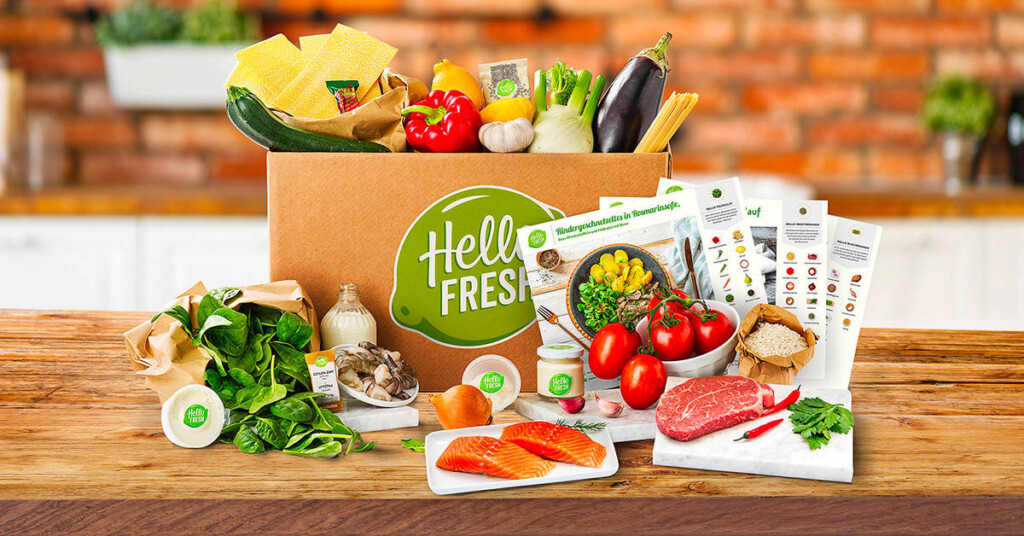Many box subscription services are booming… but some are failing or are stagnant.
Why?
Because they do their marketing wrong.
Here is a basic rule:
- Great product ideas can stumble and fail with mediocre or poor marketing or advertising.
- And, even bad product ideas can succeed and grow with great marketing… at least until cancellations become too large.
Many box subscription services don’t use the best direct response copy or follow direct response rules.
Let me give you an example:
I saw this direct mail package from HelloFresh, a box subscription service that sells cooking kits delivered to your door.
Let me tell you briefly what I found… and how you can learn from what they did right to market their service to prospects — and what they did wrong, depressing response.
- Their copy violates direct response copy rules — big time.
The HelloFresh sales letter does tell you why their service will make your life easier… but only briefly.
The copy is a response depressor. It violates key direct response copy rules.
For example, it’s “me” and company centric. Instead, it should be “you” and oriented to maximize response.
It says “we [take] all that off your plate”… “we’ll leave you”… “tell us…”
Direct response copy always focuses on the prospect — use “you” instead of “we” in your copy.
Your prospect cares about one thing: themselves. Always keep copy focused on the reader, and you’ll see response rates skyrocket.
- They don’t immediately present the benefits of their service.
Effective direct response copy will immediately stress the benefits of a product or service.
But HelloFresh’s slogan they used, “Get Cooking,” doesn’t tell me specifically why their service will benefit me.
They could have used a longer slogan that positioned their letter and a clearer presentation of immediate benefits.
Remember to emphasize benefits over features in your copy — don’t describe the characteristics of your offer… tell your prospects how it will change their lives or solve their problem.
- Their copy isn’t long enough.
HelloFresh was smart to create a letter in the direct mail piece (always the #1 part of a mailer read), but their sales letter is far too short at only 15 lines — barely enough for ½ a page.
I’ve run hundreds of tests on mailing campaigns… and found that 2-page sales letters outsell 1-page sales letters… and sometimes even a longer sales letter will outsell a 2-page sales letter.
A free offer, 2-4 pages. Ask for money, 4-8…maybe more. The most response sales letter for Mercedes? 12 pages. The most response sales letter for Motly Fool? 16 pages.
Most prospects will read your full letter and be more likely to respond to your offer when there’s more persuasive copy describing the benefits or overcoming the objections.
- No clear unique selling proposition (USP)
Every campaign – multiple times – should articulate the unique selling position proposition (USP). They did not.
Always state why your product or service is better/special.
What sets you apart for your competition.
- The call-to-action (CTA) is weak.
The letter should have had a focused, powerful and easy call-to-action (CTA).
But this did not.
For example, at the end of the sales letter, HelloFresh tells you to visit HelloFresh.com/Mail — linking to a page on their corporate website, not a special landing page designed to sell their service.
Corporate websites or homepages will depress response and confuse prospects with too many options and navigation distractions.
A unique landing page designed specifically for your direct mail offer that drives prospects to a single CTA (call-to-action) is much more effective at getting page visitors to sign up for your service.
- They signed the letter from the CEO — but a chef spokesperson would have been better.
HelloFresh’s sales letter is signed from the CEO of the company… better than a marketing or sales director, but not as effective as a celebrity chef or other chef spokesperson.
Your spokesperson can make or break your offer by increasing credibility and enhancing your reputation.
- Their sales piece included a sticky note — a great personalized touch, but with weak copy and weak placement.
I love and use sticky notes. In fact, several clients are using them now.
HelloFresh’s sales piece includes a sticky note with copy that appears to be “handwritten.” This is a great way to build relationship with the prospect, but the copy was weak.
The sticky note repeats HelloFresh’s CTA, but didn’t emphasize any additional benefits of their delivery service.
- Their direct mail piece included a value-added piece — an effective way to build
trust and relationship with prospects.
A value-added piece is one of direct mail’s big secrets to increasing response.
HelloFresh’s mail piece includes a value-added sheet. It’s a recipe with easy-to-follow steps, ingredient list, and tips. This is a great touch that most likely drove up response to their package.
A value-added piece is an additional piece of content that your prospect would find valuable, useful and worth keeping.
Value-added marketing says that you’re there to give, not take. It also increases the “pass-along” value of your mail piece.
- Their front envelope could be greatly improved.
HelloFresh’s front envelope uses a poor ink jet look. It could be so much better.
Plus, the teaser copy on the envelope should have been stronger — or a handwritten address… or using the sticky note on the front envelope instead of inside.
Plus, they should have used the value added piece as a tease.
HelloFresh’s return address is also weak — the “From” field on the envelope is simply filled out with “HelloFresh,” which will depress response. It should have been the letter signer’s name.
- Missing components.
Having the return address come from the service’s spokesperson would have been more powerful, less commercial/sales. If you’re marketing to customers, using only the campaigns name might be ok. But if you’re marketing to prospects, use their personal name.
If HelloFresh had used the principles of direct response marketing in their direct mail piece, they would have seen a far greater response. Missing was a powerful response device and lift note. Both of these would increase response.

Here are some additional strategies you must use for effective box subscription service marketing:
Use a multichannel, integrated campaign to supercharge response.
A multichannel, integrated campaign increases response because a prospect will see
your offer again and again. They might see an ad on social media first, then notice a banner ad, get an email, receive a direct mail piece, then finally click through to go to your landing page to make a purchase. An integrated approach means that prospective customers have multiple opportunities to say “yes” to your offer at the time your mailing piece arrives.
It’s a comprehensive campaign all to one tightly defined prospect universe… when the same prospect sees the multichannel marketing, it will increase response 30% or more.
Transactional Data Modeling (TDM) Postal and email list targeting.
To be successful, only use the very best postal and email lists. This requires knowledge of what works and what does not, and it takes a mixture of Transactional Data Modeling and the best direct response names. Without the right names, it doesn’t matter how good creative execution is.
If you would like to talk about your product or service or launching or growing your box subscription service marketing campaign, give us a call at 615-933-4647 or email Craig at [email protected] to share your thoughts.
